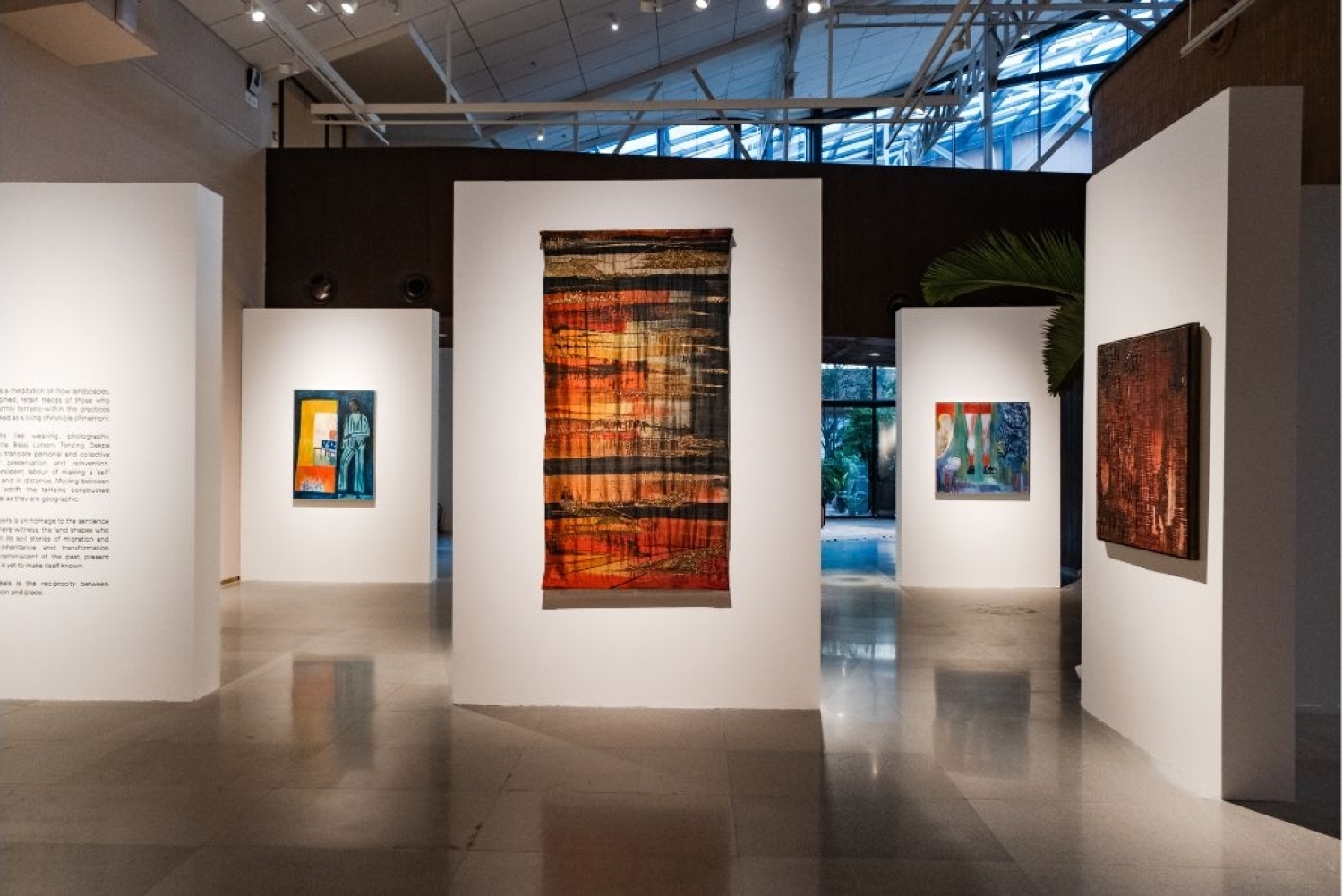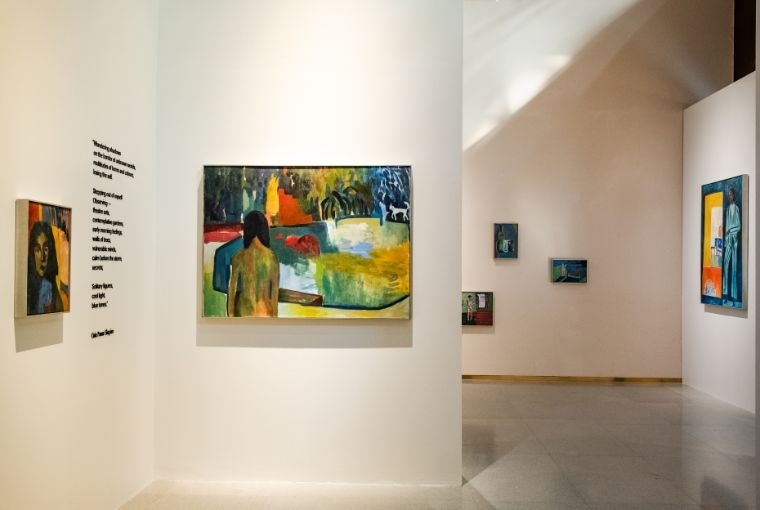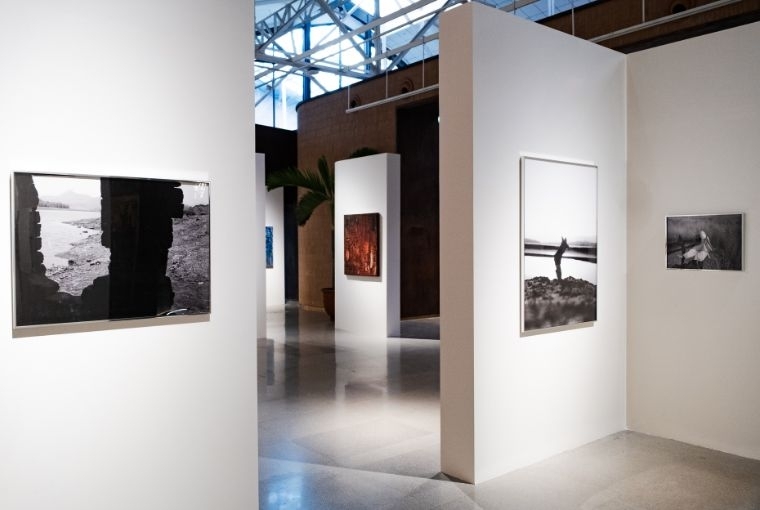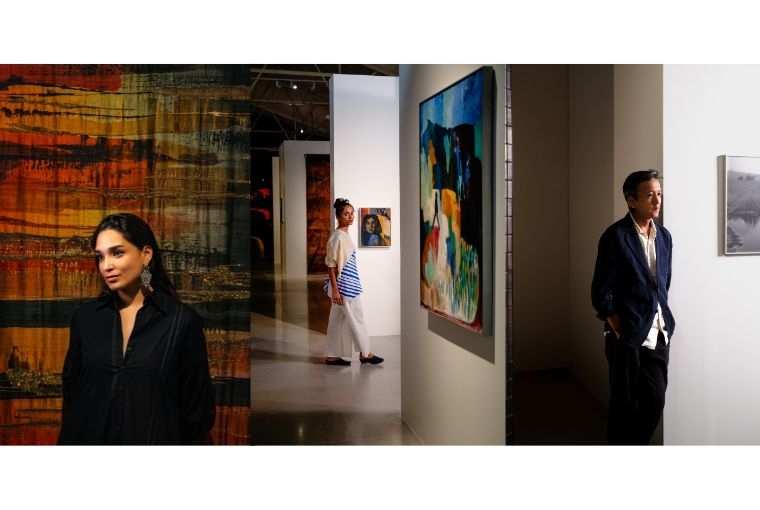

Nilaya Anthology’s next showcase titled What The Land Remembers is one that meditates on the reciprocity between person and place tracing how the land remembers those who move through it.
Gaia Pawar Shapiro’s works of art on canvas, Helena Bajaj Larsen’s experimental textile installations, and Tenzing Dakpa’s photographs translate personal and collective legacies into acts of preservation and reinvention. They trace the soft, persistent labour of making a 'self' in diaspora, in intimacy, and in distance. Moving between rootedness and being adrift, the terrains constructed are as emotional as they are geographic.
We spoke to all three of them on their inspiration, and what paying homage to home means for them.
What does paying homage to home mean for you?
Helena Bajaj Larsen: Paying homage to home is perceived as a question relating to the textile context for me has to do with building works that combine sensibilities, that relate to all of the different places that I call home, whether it’s through the places that I’m from genetically speaking, or the places that I’ve come to live in throughout my lifetime, so places that became home over time. And if my work can in some way, nod to all of these places and the ways in which they’ve shaped me, and that can manifest itself in many different ways because different cultures, cities and countries promote different tendencies in terms of design, different visual languages. Say, for example, the time that I spent in Italy taught me a lot about the use of juxtaposing motifs, and my upbringing in Scandinavia, in the earlier years of my childhood, introduced me to a visual language that was much rougher, darker and more minimal. My roots linked to India introduced me to the heavy culture surrounding ornamentation and material practices. So, I would say paying homage to home is really kind of honouring the learnings, from a visual standpoint that I’ve had, because of the different places that I’ve passed through, in these last thirty years, and then finding ways to weave that into my work, whether it’s very obvious or subconscious.
Gaia Pawar Shapiro: Home is a constant subject in my work. I am lucky to have grown up in such a beautiful place as Hampi, and that has surely influenced my interest in landscape. When I was at university in Montreal, almost all the images came directly from home. Recreating the feeling of a solitary walk early in the morning. I visualise my inner world as a safe house surrounded by a wall of trees. An isolated figure in this world is one way that I begin to explore within the frame.
Tenzing Dakpa: Paying homage to home for me means to establish a connection, to take stock and describe for myself an origin; to activate and conjure, embrace and acknowledge the history of a place and its manifestations; to be able to photograph in the most idiosyncratic and personal, yet ambiguous way possible.

What do you hope to preserve or reinvent through your art?
HBL: I think we live in a time right now where artists and designers are very keen to follow trends and also gain virality overnight, and we're in this very clickbait culture when it comes to art. I like the idea of an artist or a designer today actually taking an academic approach to what they do, and genuinely trying to gain knowledge of the space that they're trying to pierce. The way that I would like to approach my work, and have hopefully been doing so in the last five to eight years, is actually gaining an understanding through curiosity of textile as a tradition, as a history, all over the world. Not just India, but the entire global South is filled with beautiful things to learn in terms of craft communities, textile heritage and ancestral techniques with fibres. And whether it's trips I've had to South Africa, Mexico, Colombia, Saudi Arabia, or Cambodia, the list goes on.
But I find that travelling for me now has actually taken on a very different shape. Before it was always just about discovering a new country, and whether that's, for example, people, landmarks, food, how one would typically visit, let's say, a new nation. But for me now, I would say the creative aspect makes up about 50% of what I look for when I go to a new place. And that's connecting with local artists, connecting with local designers, reading books not really about the history of the place as much as the specific history of, let's say, textiles in a place or a specific kind of craft. It doesn't always have to be textiles. I think it can be linked, it can be about jewellery, it can be about product, it can be architecture. But it's this idea now that I want to travel the world with an eye that is looking for creative differences and then finding a way to learn about the global creative traditions surrounding textiles through juxtaposing and comparing my different learnings in different countries within the textile space. That's something that I wish to integrate over time, accumulate and build this library in my mind. And then be able to then pull from that library whenever I make anything new. So then that would be the reinvention part that you're talking about, the second stage. First, it's about acquisition of knowledge, acquisition of information, and then having all of that to pull from whenever I desire.
GPS: I try to capture the feelings and moods of my personal experiences of different places, times and ideas. They are images taken from my everyday life blended with the workings of my imagination. Music and literature are a big part of my process. Music is essential when I am
working; it sets the mood and takes me where I need to go for each piece.
TD: I believe photographs are a proxy to a realm where gestures, proximity, vantage and description operate simultaneously to create a larger whole. So the intent is not to preserve or reinvent but to meet half-way, to resonate with the subject matter in order to get a sense of the things/what we live with. Part of the joy in photographing is that they confound and embody more than one knows. They describe without any external means of attachment, and let the pictures sing for themselves - its significance is made possible through an engagement where our collective experiences can play out.

What does belonging mean to you, and how does your practice define that?
HBL: I think belonging for me now does not have the definition of a specific place. I think for a lot of people maybe belonging has to do with roots, linked to a particular culture like religion or family. But for me, belonging now really is a sense of comfort. If you can feel that you're kind of at ease with what you're doing and what you're pursuing then that is belonging and then it doesn't really matter where you are. If you have a strong sense of self, sense of identity and authenticity I think you can end up actually belonging anywhere. I think it translates into the work, in the sense that the work doesn't actually want to root itself in a specific message. It's not about telling a story of Indian textile or telling a story specifically of South Asian textile or telling a story of a specific kind of embroidery that's from this region or that region. It is really just a very personal contemporary sort of design aesthetic that I have, and that I'm trying to develop works that are authentic to that. But there's no sort of this obsessive desire to highlight a very, very specific culture. It really is the idea that I've been very fortunate and very blessed to experience a lot of different cultures in my life and that ideally the work is not rooted specifically in one thing and is a representation of how beautiful life can be when you do manage to actually pull everything together, and combine everything, and get to a point where you can't really tell where something is from or you can't really tell where something was made.
GPS: How the individual responds to the world around them and the world they build for themselves are things I try to answer for myself through the painting.. Soaking up what’s around you and letting yourself experience new things are an important part of ’belonging’, and something I try to hold on to as I keep working.
TD: ‘If sleep is the apogee of physical relaxation, boredom is the apogee of mental relaxation. Boredom is the dream bird that hatches the egg of experience.’ [Walter Benjamin, ‘The Storyteller’, in Illuminations, ed. by Hannah Arendt, trans. By Harry Zohn (London: Fontana Press, 1973), pp. 83-109 (p.91).]
Photography makes visible our relationship to the world, the environment we live in and in the process helps make sense of what we live with. It's a means to discovering the world and not so much an expression of its mystery. I moved to Goa in 2017, and since have worked from here—the attempt is not to understand but to resonate with the temperament of the place.
What the Land Remembers is on display till end of December at Nilaya Anthology, in Mumbai.
Date 19-11-2025

L to R: Helena Bajaj Larsen, Gaia Pawar Shapiro, Tenzing Dakpa